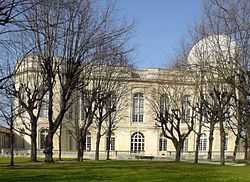Paris Observatory
Coordinates: 48°50′11.18″N 2°20′11.42″E / 48.8364389°N 2.3365056°E

The Paris Observatory (in French, Observatoire de Paris or Observatoire de Paris-Meudon) is the foremost astronomical observatory of France, and one of the largest astronomical centres in the world. Its historic building is to be found on the Left Bank of the Seine in central Paris, but most of the staff works on a satellite campus in the Meudon suburb of Paris.
Constitution

Administratively, it is a grand établissement of the French Ministry of National Education, with a status close to that of a public university. Its missions include:[1]
- research in astronomy and astrophysics;
- education (four graduate programs, Ph.D. studies);
- diffusion of knowledge to the public.
It maintains a solar observatory at Meudon (48°48′18.32″N 2°13′51.61″E / 48.8050889°N 2.2310028°E) and a radio astronomy observatory at Nançay.[1] It was also the home to the International Time Bureau until its dissolution in 1987.[2]
History

Its foundation lies in the ambitions of Jean-Baptiste Colbert to extend France's maritime power and international trade in the 17th century. Louis XIV promoted its construction starting in 1667,[3] being completed in 1671. It thus predates by a few years the Royal Greenwich Observatory in England, which was founded in 1675. The architect of the Paris Observatory was Claude Perrault whose brother, Charles, was secretary to Colbert and superintendent of public works.[4] Optical instruments were supplied by Giuseppe Campani. The buildings were extended in 1730, 1810, 1834, 1850, and 1951.[3] The last extension incorporates the spectacular Meridian Room designed by Jean Prouvé.[5]
The world's first national almanac, the Connaissance des temps was published by the observatory in 1679, using eclipses in Jupiter's satellites to aid sea-farers in establishing longitude. In 1863, the observatory published the first modern weather maps. In 1882, a 33 cm (13 in) astrographic lens was constructed, an instrument that catalysed what proved to be the over-ambitious, international Carte du Ciel project.[citation needed]
In November 1913, the Paris Observatory, using the Eiffel Tower as an antenna, exchanged sustained wireless (radio) signals with the United States Naval Observatory to determine the exact difference of longitude between the two institutions.[6]
Meudon 83-cm Great Refractor
The Meudon great refractor (Meudon 83-cm) was a 83 cm (33 in) aperture refractor, which with September 20, 1909 observations by E.M. Antoniadi helped disprove the Mars canals theory. It was a double telescope completed in 1891, with secondary having 62 cm (24 in) aperture lens for photography. It was one of the largest active telescopes in Europe.
Directors
The title of director of the Observatory was officially given for the first time to César-François Cassini de Thury by a Royal brevet dated November 12, 1771.[7] However, the important role played by his grandfather and father in this institution during its first century actually gives them somewhat the role of director.
|
|
Facilities
Paris
Meudon

- Solar Observatory Tower Meudon
- Chateau de Meudon
- LESIA space and astrophysics instrumentation research laboratory[8]
Nançay
Saint-Véran
Also known as the Observatoire du Pic de Château Renard, the Observatoire de Saint-Véran was built in 1974 on top of the Pic de Château Renard (2,900 m or 9,500 ft), on the commune of Saint-Véran in the Haut Queyras (Hautes Alpes département). A coronograph was in operation there for ten years; the dome was moved there from the Perrault building of the Observatoire de Paris.[citation needed]
Nowadays, the AstroQueyras amateur astronomy association operates the facility, using a 60 cm (24 in) telescope on loan from the Observatoire de Haute Provence. Numerous asteroids have been discovered there.[9]
References
- ↑ 1.0 1.1 "The Paris Observatory". l'Observatoire de Paris. Retrieved 2007-08-27.
- ↑ Guinot (2000)
- ↑ 3.0 3.1 [Anon.] (2001) "Paris Observatory", Encyclopaedia Britannica, Deluxe CDROM edition
- ↑ [Anon.] (2001) "Perrault, Claude", Encyclopaedia Britannica, Deluxe CDROM edition
- ↑ [Anon.] (2001) "Prouvé, Jean", Encyclopaedia Britannica, Deluxe CDROM edition
- ↑ "Paris Time By Wireless," New York Times, Nov 22, 1913, pg 1.
- ↑ Archives nationales, O1 117, fol. 991-993. See also Charles Wolf, Histoire de l'Observatoire de Paris de sa fondation à 1793, Paris : Gauthier-Villars, 1902, p. 194 and following.
- ↑ "Completion and delivery of equipment bay and camera to CNES mark major project milestone" (Press release). Released jointly by Observatoire de Paris, CNES and CNRS-INSU. 2005-06-30. Retrieved 2008-08-03.
- ↑ "L'Observatoire du Pic de Château Renard (2900 m)". Histoire (in French). l'Observatoire de Paris. Retrieved 2007-08-27.
Bibliography
- [Anon.] (2001) "Paris Observatory", Encyclopaedia Britannica, Deluxe CDROM edition
- Aubin, D. (2003). "The fading star of the Paris Observatory in the nineteenth century: astronomers' urban culture of circulation and observation". Osiris 18: 79–100. doi:10.1086/649378.
- Guinot, B. (2000). "History of the Bureau International de l'Heure". Polar Motion: Historical and Scientific problems. pp. 175–184.
External links
| Wikimedia Commons has media related to Observatoire de Paris. |
- The Paris Observatory (official site, in English)
- History at official site
- location in Paris
- Publications of the Observatoire de Paris in Gallica, the digital library of the BnF.
| ||||||||||||||||||||||||||||